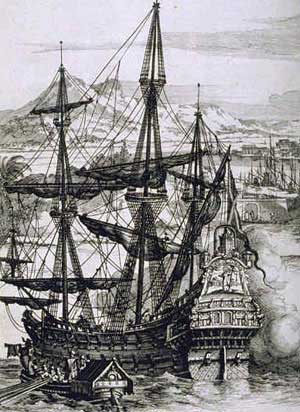
ガレオン船
Galleon
ス
ペインのガレオン船、デューラー画
☆
ガレオン船は、スペインとポルトガルで開発された大型の多層甲板帆船だ。[3][検証失敗][4][検証失敗] [5][出典必要][6]
16世紀から18世紀の帆船時代、ヨーロッパ人によって武装した貨物船として初めて使用され、17世紀半ばの英蘭戦争まで、軍艦として主に採用された船
だった。[7]
ガレオン船は一般的に3本以上のマストを備え、後部のマストにはラテン式の前後帆装を採用し、カーベル構造で角張った高い船尾を持ち、前マストとメインマ
ストには四角帆装を採用していた。
このような船は16世紀から17世紀にかけて商業において重要な役割を果たし、しばしば補助的な海軍戦艦として徴用された。実際、探検の時代の大部分(約
150年間)において、対立する艦隊の主力艦として活躍したが、アンゴラ・オランダ戦争により、帆船時代後半には専用設計の戦艦が海上での主流となった。
| Galleons were large,
multi-decked sailing ships developed in Spain and Portugal.[3][failed
verification][4][failed verification] [5][full citation needed][6] They
were first used as armed cargo carriers by Europeans from the 16th to
18th centuries during the Age of Sail, and they were the principal
vessels drafted for use as warships until the Anglo-Dutch Wars of the
mid-17th century.[7] Galleons generally carried three or more masts
with a lateen fore-and-aft rig on the rear masts, were carvel built
with a prominent squared off raised stern, and used square-rigged sail
plans on their fore-mast and main-masts. Such ships played a major role in commerce in the sixteenth and seventeenth centuries and were often drafted into use as auxiliary naval war vessels—indeed, they were the mainstay of contending fleets through most of the 150 years of the Age of Exploration—before the Anglo-Dutch wars made purpose-built warships dominant at sea during the remainder of the Age of Sail. |
ガレオン船は、スペインとポルトガルで開発された大型の多層甲板帆船
だ。[3][検証失敗][4][検証失敗] [5][出典必要][6]
16世紀から18世紀の帆船時代、ヨーロッパ人によって武装した貨物船として初めて使用され、17世紀半ばの英蘭戦争まで、軍艦として主に採用された船
だった。[7]
ガレオン船は一般的に3本以上のマストを備え、後部のマストにはラテン式の前後帆装を採用し、カーベル構造で角張った高い船尾を持ち、前マストとメインマ
ストには四角帆装を採用していた。 このような船は16世紀から17世紀にかけて商業において重要な役割を果たし、しばしば補助的な海軍戦艦として徴用された。実際、探検の時代の大部分(約 150年間)において、対立する艦隊の主力艦として活躍したが、アンゴラ・オランダ戦争により、帆船時代後半には専用設計の戦艦が海上での主流となった。 |
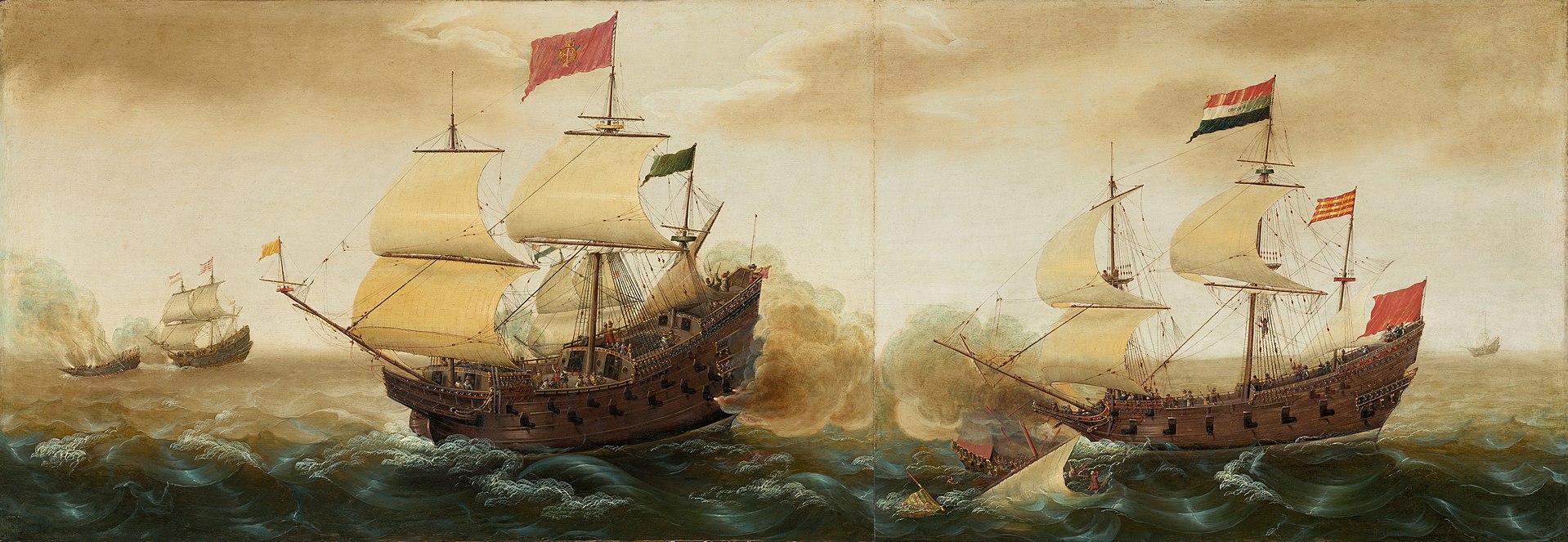 A Spanish galleon (left) firing its cannons at a Dutch warship (right). Cornelis Verbeeck, c. 1618–1620 |
 スペインのガレオン船(左)がオランダの軍艦(右)に向けて大砲を発射している。コーネリス・フェルベーク、1618年頃~1620年頃 |
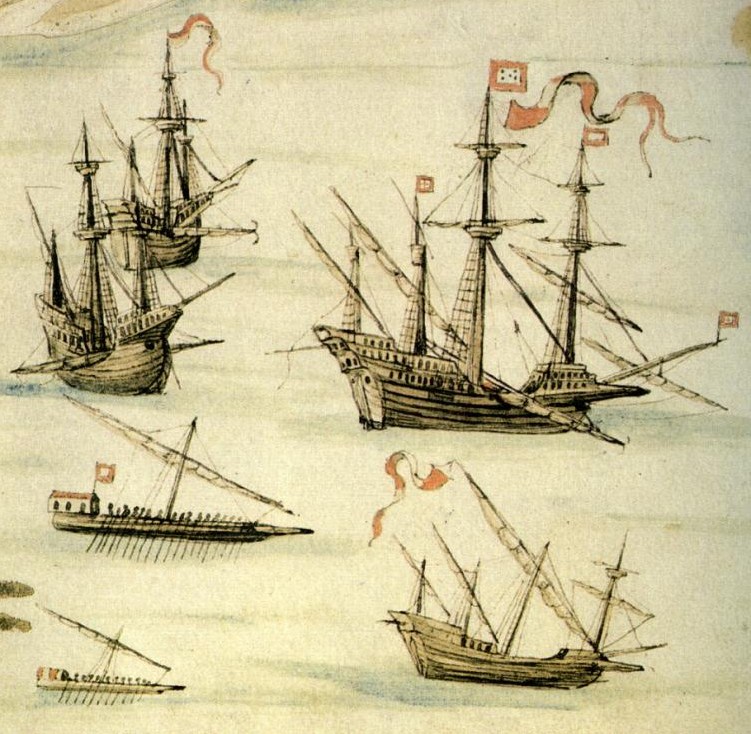 Carracks, galleon (center/right), square rigged caravel (below), galley and fusta (galliot) depicted by D. João de Castro on the "Suez Expedition" (part of the Portuguese Armada of 72 ships sent against the Ottoman fleet at anchor in Suez, Egypt, in response to its entry in the Indian Ocean and the siege of Diu in 1538) — Tábuas da India in the João de Castro's Roteiro do Mar Roxo (Routemap of the Red Sea) of 1540–1541.[2] |
 カラック船、ガレオン船(中央/右)、四角帆のカラベル船(下)、ガレー船とフスタ(ガリオット)を、D. ジョアン・デ・カストロが「スエズ遠征」に描いたもの (1538年にインド洋に進出し、ディウを包囲したオスマン帝国艦隊に対抗して、エジプトのスエズに停泊していたオスマン帝国艦隊に対して派遣された 72 隻のポルトガル艦隊の一部) — 1540年から1541年にジョアン・デ・カストロが著した『Roteiro do Mar Roxo(紅海航路図)』に掲載された「Tábuas da India(インドの図板)」。[2] |
| Terminology The word galleon has had differing meanings at different points in its history and in different regions. The term is thought to originate from gallioni (alternatively galeanni[8]: 16 ), Venetian oared vessels that were used in rivers in the fifteenth century. The galleons of the sixteenth and seventeenth centuries were fully developed sailing ships.[9]: 98–99 This descriptive name was used notably in Spain, Portugal and Venice. However, inconsistency can be found, for example, in the use of "galleon" by the notaries who worked in the Basque shipbuilding region of northern Spain. Though most of the ships from this region were naos, some were galeones, but the two terms can be found being used as if they were interchangeable by some of the writers of the documents in the contemporary archives.[8]: 14-16 It is thought that the seamen of the Basque country of northern Spain were clear on the differences between a nao and a galeón, but what those distinguishing features were is not apparent to modern historians. A hypothesis has been put forward that the differences are more in the underwater hull shape – something which cannot be discerned in contemporary illustrations.[8]: 14–16 The terminological inconsistency of Basque-built ships continues into the present day. Archival research on the Red Bay wreck 24M has identified, with reasonable confidence, this ship to have been San Juan of Pasajes. She is described 26 times in six different contemporary documents with at least three different authors as a nao, and not once as a galeón. However, published archaeological work repeatedly refers to this ship as a galleon.[8]: 15, 114, 216 [10]: 83 Outside of the Iberian peninsula, the term "galleon" was not often used. For instance, though English shipwrights certainly built galleon-type vessels, they simply referred to them as "ships". In present-day usage, these types are referred to as galleons, with the term "race-built galleon" being applied to those with lower upper-works.[10]: 115 [9]: 106 In Holland, a "pinnas" was a galleon-type ship and in the Baltic, "kravel" was used (a term connected with their carvel construction).[10]: 114 |
用語 「ガレオン」という言葉は、その歴史や地域によって異なる意味を持ってきました。この用語は、15 世紀に川で使用されていたヴェネツィアの漕ぎ船「ガリオニ(別名ガレアニ[8]: 16 )」に由来すると考えられています。16世紀から17世紀のガレ オン船は、完全に発達した帆船だった[9]: 98–99。この記述的な名称は、スペイン、ポルトガル、ヴェネツィアで特に使用された。ただし、不一致も 見られる。例えば、スペイン北部のバスク地方の造船地域で働いていた公証人が「ガレオン」という用語を使用している場合がある。この地域の船のほとんどは ナオでしたが、一部はガレオン船でした。しかし、当時の文書を執筆した一部の作家は、この2つの用語を互換的に使用しているように見受けられます。 [8]: 14-16 スペイン北部のバスク地方の船員たちは、ナオとガレオンの違いを明確に理解していたと考えられていますが、その区別は現代の歴史家には明らかではありませ ん。その違いは、当時の図では確認できない船体の水中の形状にあるのではないかという仮説が提唱されています[8]: 14–16。 バスクで建造された船の用語の矛盾は、現在まで続いている。レッドベイの難破船 24M に関するアーカイブ調査により、この船はサン・フアン・デ・パサヘス号であったと、かなりの確信を持って特定された。この船は、6 つの異なる同時代の文書に 26 回、少なくとも 3 人の異なる著者によってナオと記述されており、ガレオンと記述されているものは 1 件もない。しかし、出版された考古学研究では、この船を繰り返しガレオン船と呼んでいる。[8]: 15, 114, 216 [10]: 83 イベリア半島以外では、「ガレオン」という用語はあまり使用されていませんでした。たとえば、英国の造船技師は確かにガレオン型の船を建造していました が、それらを単に「船」と呼んでいました。現在の用法では、これらのタイプはガレオンと呼ばれ、上部構造が低いものは「人種建造ガレオン」と呼ばれていま す。[10]: 115 [9]: 106 オランダでは「ピナス」がガレオン船型の船を指し、バルト海では「クラヴェル」という用語が使われていた(これはそのカーベル構造と関連している)。 [10]: 114 |
| History This section's factual accuracy is disputed. Relevant discussion may be found on the talk page. Please help to ensure that disputed statements are reliably sourced. (December 2023) (Learn how and when to remove this message) During the 16th century, a lowering of the carrack's forecastle and elongation of the hull gave the ocean-going ships an unprecedented level of stability in the water, and reduced wind resistance at the front, leading to a faster, more maneuverable vessel. The galleon differed from the carrack and other older types primarily by being longer, lower and narrower, with a square tuck stern instead of a round tuck, and by having a snout or head projecting forward from the bows below the level of the forecastle. While carracks could be very large for the time, with some Portuguese carracks over 1,000 tons, galleons were generally smaller, usually under 500 tons although some Manila galleons were to reach a displacement of 2,000 tons. With the introduction of the galleon in Portuguese India Armadas during the first quarter of the 16th century,[11][12] carracks' armament was reduced as they became almost exclusively cargo ships (which is why the Portuguese carracks were pushed to such large sizes), leaving any fighting to be done to the galleons. One of the largest and most famous of Portuguese galleons was the São João Baptista (nicknamed Botafogo, "Spitfire"), a 1,000-ton galleon built in 1534, said to have carried 366 guns. Friar Manuel Homem says that this galleon mounted 366 bronze pieces of artillery, including the ones that garrisoned the high castles of stern and bow.[13] Carracks were usually lightly armed and used for transporting cargo in all the fleets of other Western European states, while galleons were stronger, more heavily armed, and also cheaper to build for the same displacement (five galleons could cost around the same as three carracks) and were therefore a much better investment for use as heavily armed cargo ships or warships. Galleons' design changed and improved through the application of various innovations, and they were particularly linked with the military capabilities of the Atlantic sea powers. It was the captains of the Spanish navy, Pedro Menéndez de Avilés and Álvaro de Bazán, who designed the definitive long and relatively narrow hulled galleon in the 1550s.[14][15] The galleon was powered entirely by wind, using sails carried on three or four masts, with a lateen sail continuing to be used on the last (usually third and fourth) masts. They were used in both military and trade applications, most famously in the Spanish treasure fleet, and the Manila galleons. While carracks played the leading role in early global explorations, galleons also played a part in the 16th and 17th centuries. In fact, galleons were so versatile that a single vessel might be refitted for wartime and peacetime roles several times during its lifespan. The principal warships of the opposing English and Spanish fleets in the 1588 confrontation of the Spanish Armada and in the 1589 confrontation of the English Armada were galleons, with the modified English race-built galleons developed by John Hawkins proving their great utility in combat, while the capacious Spanish galleons, designed primarily as transports, showed great endurance in the battles and in the long and stormy return home. |
歴史 このセクションの事実の正確性については議論があります。関連する議論はトークページをご覧ください。議論のある記述は、信頼できる出典で裏付けられるようご協力ください。(2023年12月) (このメッセージの削除方法についてはこちらをご覧ください) 16世紀、カラックの船首を低くし、船体を延長することで、海洋航行船は水面での安定性が飛躍的に向上し、船首の風抵抗が減少した。これにより、より速 く、操縦性の高い船舶が実現した。ガレオン船は、カラック船やその他の古いタイプの船とは、主に、より長く、より低く、より狭く、丸い船尾ではなく四角い 船尾を持ち、船首から船首楼の高さより前に突き出た船首や頭部がある点で異なっていた。カラックは当時の船としては非常に大型で、ポルトガルのカラックの 一部は1,000トンを超えるものもあったが、ガレオン船は一般的に小型で、通常は500トン未満だったが、マニラ・ガレオン船の一部は2,000トンの 排水量に達した。16世紀前半にポルトガルインド艦隊にガレオンが導入されると[11][12]、カラックの武装は削減され、ほぼ完全に貨物船として使用 されるようになった(これがポルトガルカラックが大型化した理由だ)。戦闘任務はガレオンに委ねられた。ポルトガル最大のガレオン船の一つで最も有名なの は、1534年に建造された1,000トン級のガレオン船「サン・ジョアン・バチスタ」(愛称「ボタフォゴ」、直訳「火の玉」)で、366門の砲を搭載し ていたと伝えられている。修道士マヌエル・オメーンは、このガレオン船には、船尾と船首の高城に配置された砲を含む366門の青銅製大砲が搭載されていた と述べています。[13] カラック船は通常、武装が軽く、他の西ヨーロッパ諸国の艦隊で貨物輸送に使用されていた。一方、ガレオン船はより頑丈で、重武装であり、同じ排水量の場 合、建造費も安かった(5隻のガレオン船の建造費は3隻のカラック船とほぼ同じだった)ため、重武装の貨物船や軍艦として使用するにははるかに優れた投資 対象だった。ガレオン船の設計は、さまざまな革新の適用によって変化し、改良され、大西洋の海洋大国々の軍事力と特に関連していた。1550年代に、決定 的な、長くて比較的狭い船体のガレオン船を設計したのは、スペイン海軍の船長、ペドロ・メネンデス・デ・アビレスとアルバロ・デ・バザンだった。[14] [15] ガレオン船は、3本または4本のマストに帆を掲げて風力だけで推進し、最後の(通常は3本目と4本目)のマストにはラテン帆が引き続き使用されていた。ガ レオン船は軍事および貿易の両方に使用され、最も有名なのはスペインの財宝船団とマニラガレオン船だ。カラック船が初期のグローバル探検で主導的な役割を 果たした一方、ガレオン船も16世紀と17世紀に重要な役割を果たした。実際、ガレオン船は極めて多目的で、その生涯において戦争用と平和用の役割に複数 回改装されることもあった。 1588 年のスペイン艦隊と 1589 年のイギリス艦隊の対決では、敵対するイギリスとスペインの艦隊の主な軍艦はガレオン船でした。ジョン・ホーキンスが開発した、人種に合わせて改良された イギリスのガレオン船は、戦闘での優れた実用性を発揮し、主に輸送用に設計された容量の大きいスペインのガレオン船は、戦闘や、嵐の激しい長い帰路で、そ の優れた耐久性を発揮しました。 |
| Construction This section does not cite any sources. Please help improve this section by adding citations to reliable sources. Unsourced material may be challenged and removed. (May 2024) (Learn how and when to remove this message) 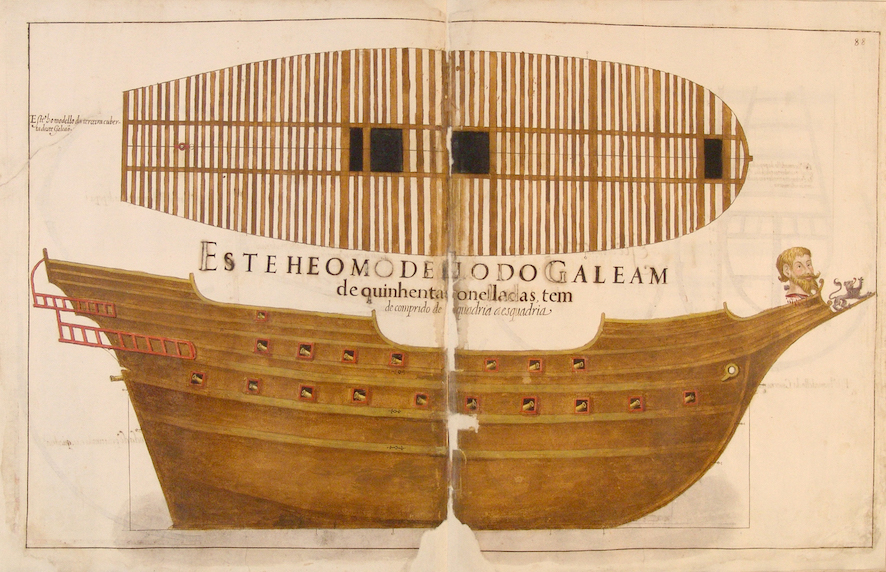 Technical drawing of a late 16th century or early 17th century Portuguese galleon, featured in the Livro de Traças de Carpintaria 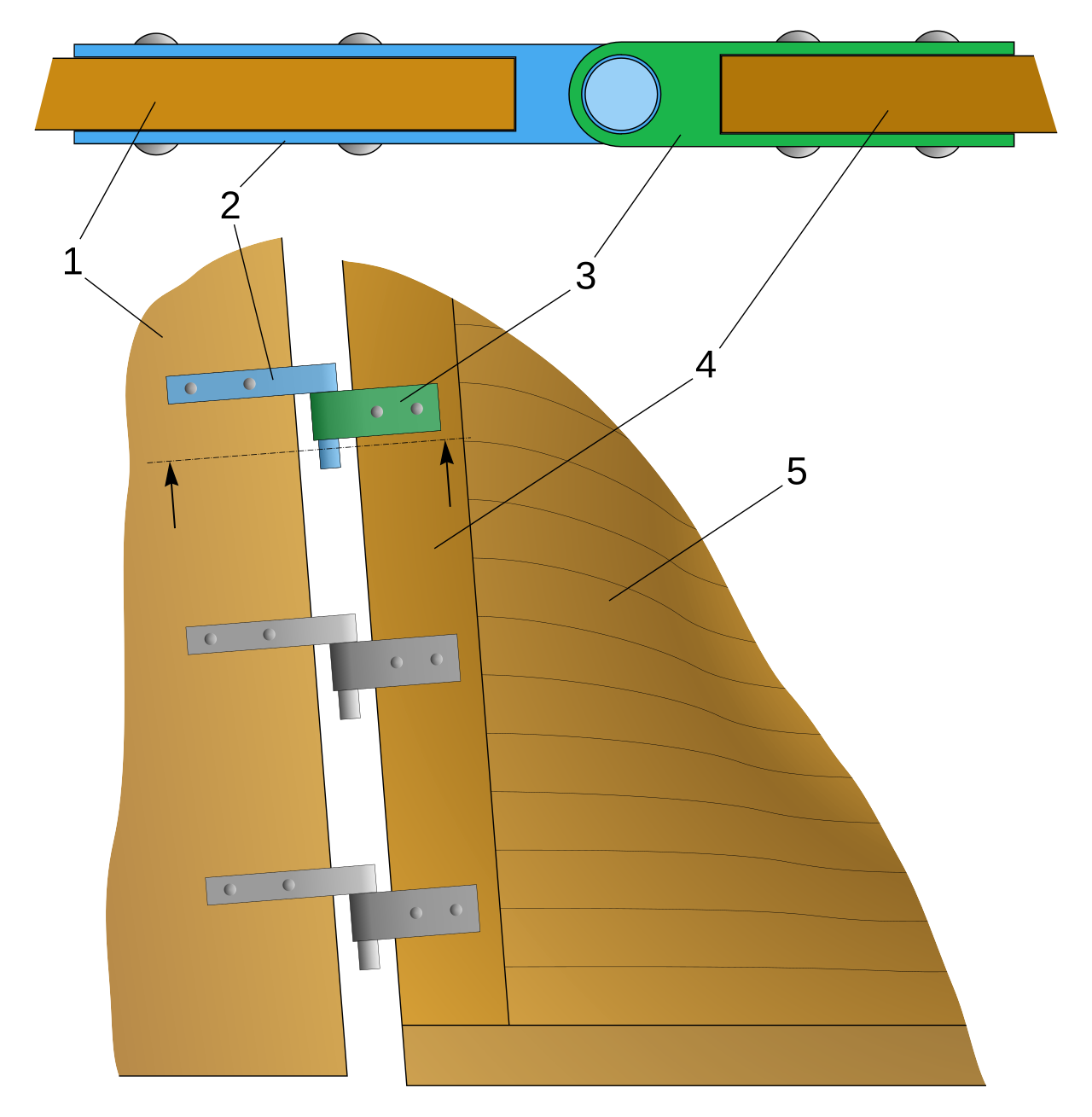 The galleon's pintle and gudgeon rudder Galleons were constructed from oak (for the keel), pine (for the masts) and various hardwoods for hull and decking. Hulls were usually carvel-built. The expenses involved in galleon construction were enormous. Hundreds of expert tradesmen (including carpenters, pitch-melters, blacksmiths, coopers, shipwrights, etc.) worked for months before a galleon was seaworthy. To cover the expense, galleons were often funded by groups of wealthy businessmen who pooled resources for a new ship. Therefore, most galleons were originally consigned for trade, although those captured by rival states were usually put into military service. The most common gun used aboard a galleon was the demi-culverin, although gun sizes up to demi-cannon were possible. Because of the long periods often spent at sea and poor conditions on board, many of the crew often perished during the voyage; therefore advanced rigging systems were developed so that the vessel could be sailed home by an active sailing crew a fraction of the size aboard at departure.[citation needed] |
構造 このセクションには出典が記載されていません。信頼できる出典を追加して、このセクションの改善にご協力ください。出典が記載されていない情報は、検証され、削除される可能性があります。(2024年5月) (このメッセージの削除方法についてはこちらをご覧ください)  16世紀後半から17世紀初頭のポルトガル製ガレオン船の技術図面、『Livro de Traças de Carpintaria』に掲載  ガレオン船のピントルとガジョン舵 ガレオン船は、キールにはオーク材、マストには松材、船体と甲板にはさまざまな硬材を使用して建造されていました。船体は通常、カーベル構造でした。ガレ オン船の建造には莫大な費用がかかりました。何百人もの熟練した職人(大工、ピッチ溶解工、鍛冶屋、クーパー、造船工など)が、ガレオン船が航海可能にな るまでに何ヶ月もかけて作業を行った。その費用を賄うため、ガレオン船は多くの場合、新しい船の建造資金を出し合った裕福な商人グループによって資金が調 達されていた。そのため、ほとんどのガレオン船はもともと貿易用に建造されたが、敵国によって捕獲されたものは通常、軍用船として使用された。 ガレオン船で最もよく使用されていた大砲はデミカルベリンだったが、デミキャノンまでの大きさの大砲も使用可能だった。 航海期間が長く、船内の生活環境も悪かったため、多くの乗組員が航海中に命を落とした。そのため、出航時の乗組員数よりもはるかに少ない人数で船を操船できる、高度な索具システムが開発された。 |
| Distinguishing features This section does not cite any sources. Please help improve this section by adding citations to reliable sources. Unsourced material may be challenged and removed. (May 2024) (Learn how and when to remove this message) 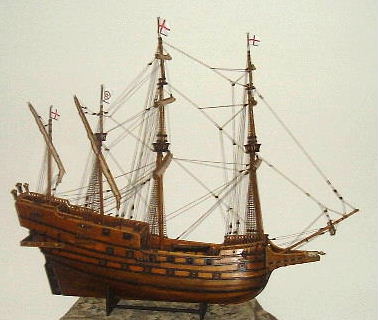 Model of an English galleon sporting four mast types: (left to right) • Bonaventure mizzenmast, typically lateen-rigged and shorter than the main mizzen. • Mizzenmast, typically shorter than the foremast and lateen-rigged. • Mainmast, the tallest mast and, on vessels with more than three masts, the most centrally located. • Foremast, the second-tallest mast. 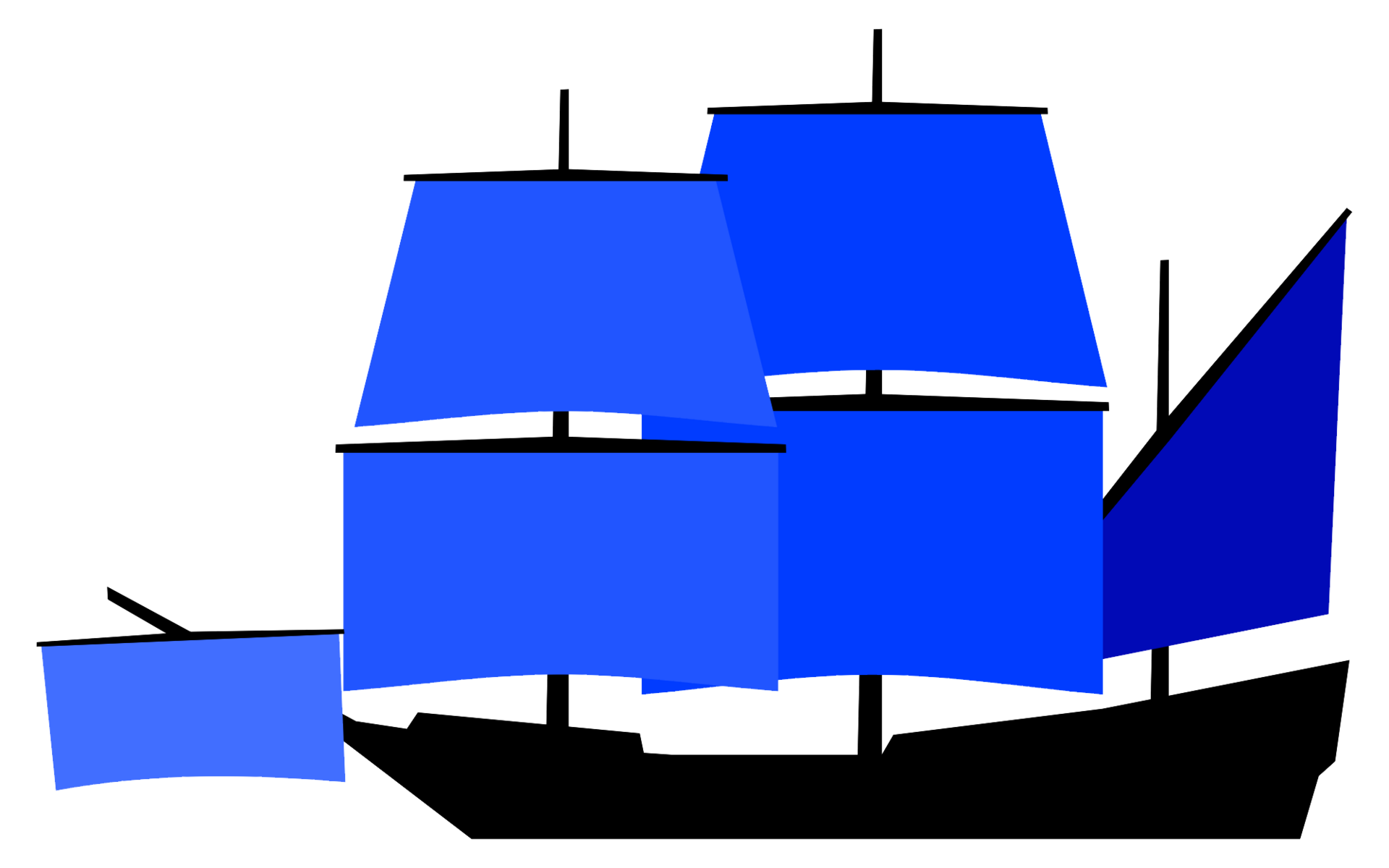 A three-masted vessel, square-rigged on the foremast and mainmast and lateen-rigged on the mizzenmast. The most distinguishing features of the galleon include the long, prominent beak or beakhead followed by a foremast and mainmast, both noticeably taller than the single or double lateen-rigged mizzenmasts with their sloped lateen-rig yards, and below the square quarter gallery at the stern. On average with three masts, in larger galleons, a fourth mast was added, usually another lateen-rigged mizzen, called the bonaventure mizzen. |
特徴 このセクションには出典が記載されていません。信頼できる出典を追加して、このセクションを改善してください。出典が記載されていない情報は、削除される可能性があります。(2024年5月) (このメッセージの削除方法についてはこちらをご覧ください)  4種類のマストを備えたイギリス型ガレオン船のモデル:(左から右へ) • ボナベンチャー・ミズンマスト:通常、ラテン帆装で、メイン・ミズンよりも短い。 • ミズンマスト:通常、フォアマストよりも短く、ラテン帆装。 • メインマスト:最も高いマストで、3本以上のマストを備えた船では最も中央に位置する。 • 前マスト:2番目に高いマスト。  3本のマストを備えた船で、前マストとメインマストはスクエア・リグ、ミズンマストはラテン・リグ。 ガレオン船の最も特徴的な点は、長い目立つ船首(ビークまたはビークヘッド)に続き、フォアマストとメインマストが、傾斜したラテン帆装のヤードを持つ単 一または二重のラテン帆装ミズンマストよりも著しく高く、船尾のスクエア・クォーター・ギャラリーの下に位置していることだ。平均的に3本のマストを有す るガレオン船では、大型のものに4本目のマストが追加され、通常はラテン帆装のミズンマストで、ボナベンチュラ・ミズンと呼ばれる。 |
Notable galleons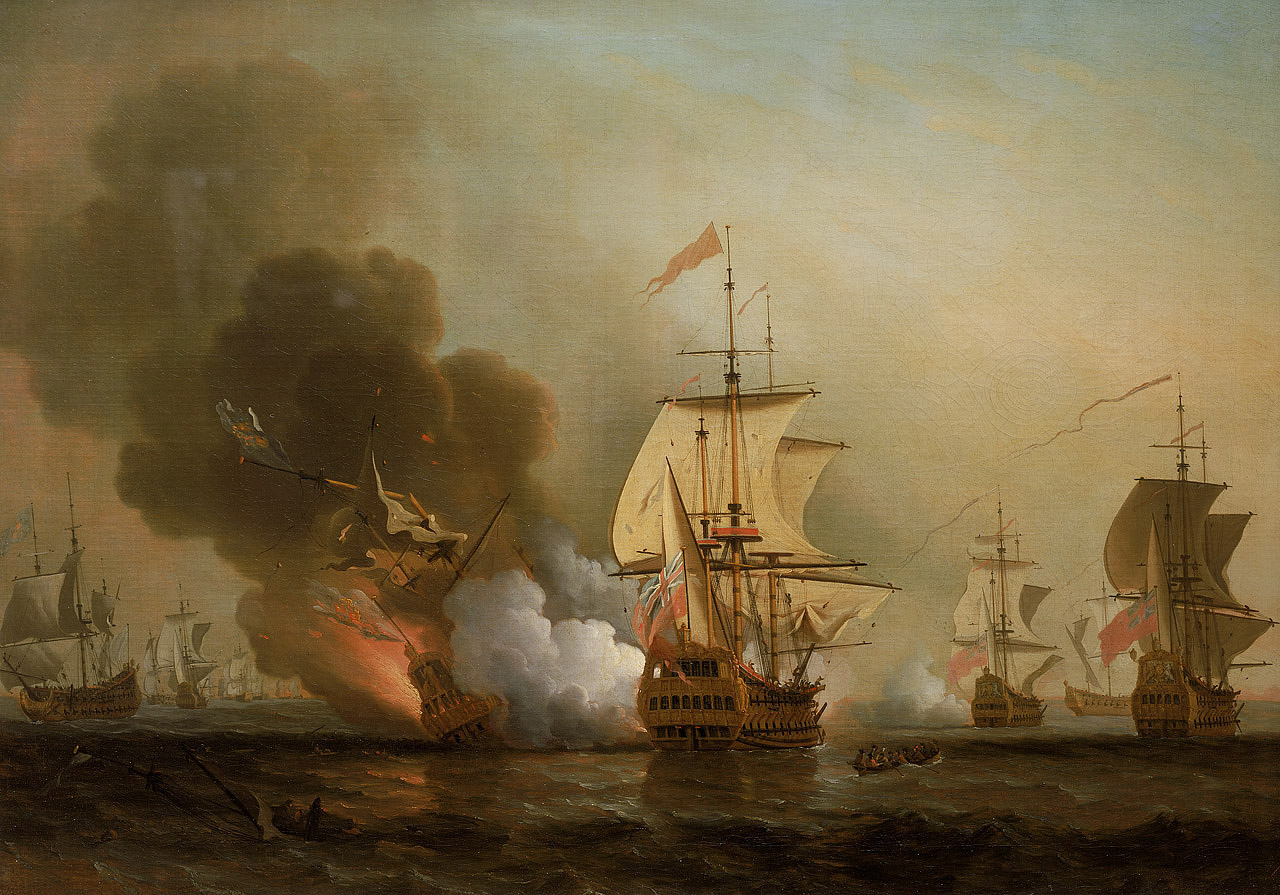 Wager's Action off Cartagena by Samuel Scott shows the 1708 sinking of the Spanish galleon San José Adler von Lübeck, the largest ship of its day when launched in 1566. Dainty, ship with which Sir Richard Hawkins sought to emulate the circumnavigation voyage of his cousin Francis Drake. She was captured by the Spanish in the action of Atacames Bay in 1594 and served in the Spanish Navy in the South American Pacific for several years. Revenge, a galleon built in 1577, the flagship of Sir Francis Drake in the Battle of the Spanish Armada in 1588, was captured by a Spanish fleet off Flores in the Azores in 1591 and sank while being sailed back to Spain. Triumph, the largest Elizabethan galleon; flagship of Sir Martin Frobisher in the Battle of the Spanish Armada. Galeon Andalucia, a replica galleon built in Spain in 2014. Golden Hind, the ship in which Sir Francis Drake circumnavigated the globe 1577–1580. "La Galga", the Assateague Spanish galleon that was shipwrecked in 1794; according to legend, the ancestors of the now famous Chincoteague ponies swam ashore from its hold. Nuestra Señora de la Concepción, a Spanish galleon, known to her crew as Cacafuego for her strong cannon.[17] She was captured by Sir Francis Drake in 1578 and all her treasures were brought to England. She was holding treasures mined in one year by the Spanish in the Americas. Padre Eterno, a Portuguese galleon launched in 1663. She was considered to be the biggest ship of her time, carrying 144 pieces of artillery with a displacement up to 2,000 tons. San Juan Bautista (originally called Date Maru, 伊達丸 in Japanese). She crossed the Pacific Ocean from Japan to New Spain in 1614. She was of the Spanish galleon type, known in Japan as Nanban-Sen (南蛮船). San Salvador, flagship vessel in Juan Rodríguez Cabrillo's 1542 exploration of present-day California in the United States. Santa Luzia, a Portuguese galleon known for defeating a Dutch squadron single-handedly twice in 1650. Santa Teresa, a Portuguese galleon, the flagship of Admiral Lope de Hoces at the Battle of the Downs, in 1639. São João Baptista, nicknamed Botafogo, the most powerful warship in the world at the time when launched (1534) by the Portuguese; became famous during the Conquest of Tunis (1535), where it was commanded by Luís of Portugal, Duke of Beja. São Martinho, a Portuguese galleon, the flagship of Duke of Medina Sidonia, commander-in-chief of the Spanish Armada. Vasa, the only original galleon to be preserved. She sank in 1628 and was raised in 1961 for preservation as a museum ship. Ark Raleigh was designed and built by Sir Walter Raleigh. She was later chosen by Lord Howard, admiral of the fleet to be the flagship of the English fleet in the fight against the Spanish Armada in 1588 and was summarily renamed Ark Royal. San Pelayo, the large 906-ton galleon, which served as the flagship of Pedro Menéndez de Avilés during his expedition to establish St. Augustine, Florida in 1565. The vessel was so large it could not enter St. Augustine's harbor, so Menendez ordered it offloaded and sent it back to Hispaniola. At a later date her crew mutinied and sailed to Europe where the ship wrecked off the coast of Denmark. The Manila galleons, Spanish trading ships that sailed once or twice per year across the Pacific Ocean between Manila in the Philippines and Acapulco in New Spain (now Mexico); (1565–1815). |
著名なガレオン船 サミュエル・スコット作「カルタヘナ沖のウェージャーの戦い」は、1708年に沈没したスペインのガレオン船サン・ホセを描いた作品。 アドラー・フォン・リューベックは、1566年に就航した当時最大級の船。 ダインティは、リチャード・ホーキンス卿が、従兄弟のフランシス・ドレイクの世界一周航海を模倣しようとした船。1594 年のアタカメス湾の戦闘でスペイン軍に捕獲され、南米太平洋で数年間、スペイン海軍に所属した。 1577 年に建造されたガレオン船「リベンジ」は、1588 年のスペイン艦隊の戦いでフランシス・ドレイク卿の旗艦を務めたが、1591 年にアゾレス諸島のフローレス沖でスペイン艦隊に捕獲され、スペインへの帰路で沈没した。 エリザベス朝最大のガレオン船「トライアンフ」は、スペイン無敵艦隊の戦いでサー・マーティン・フロビッシャーの旗艦だった。 ガレオン・アンダルシアは、2014年にスペインで建造されたレプリカガレオン船だ。 ゴールデン・ハインズ、1577年から1580年にフランシス・ドレイク卿が世界一周航海に使用した船。 1794年に難破したアサティーグのスペインのガレオン船「ラ・ガルガ」。伝説によると、現在有名なチンコティーグのポニーの祖先は、この船の船倉から泳いで上陸したと言われています。 ヌエストラ・セニョーラ・デ・ラ・コンセプシオン、スペインのガレオン船。その強力な大砲から、乗組員からは「カカフエゴ」と呼ばれていた。1578年に フランシス・ドレイク卿に捕獲され、その財宝はすべてイギリスに持ち帰られた。この船には、スペインが 1 年間にアメリカ大陸で採掘した財宝が積まれていた。 パドレ・エテルノ、1663年に就航したポルトガルのガレオン船。当時最大の船とされ、144門の大砲を搭載し、排水量2,000トンに達した。 サン・フアン・バウティスタ(元名:伊達丸)。1614年に日本からニュー・スペイン(現在のメキシコ)へ太平洋を横断した。スペインのガレオン船で、日本では「南蛮船」と呼ばれていた。 サン・サルバドルは、1542年にフアン・ロドリゲス・カブリロが現在のアメリカ合衆国カリフォルニア州を探検した際の旗艦だった。 サンタ・ルジアは、1650年にオランダ艦隊を単独で2度撃破したことで知られるポルトガルガレオン船だ。 サンタ・テレサは、1639年のダウンズ海戦でロペ・デ・ホセス提督の旗艦を務めたポルトガルガレオン船だ。 サン・ジョアン・バチスタ(São João Baptista)、愛称ボタフォゴ(Botafogo)。ポルトガルが建造した当時世界最強の戦艦(1534年就役)。1535年のチュニス征服戦で、 ポルトガルのルイス・デ・ポルトガル(ルイス・デ・ポルトガル公)の指揮下で有名になった。 サン・マルティンホ(São Martinho)、ポルトガル製のガレオン船。スペイン無敵艦隊の総司令官メディナ・シドニア公の旗艦。 ヴァサは、現存する唯一のオリジナルガレオン船。1628年に沈没したが、1961年に博物館船として保存のため引き上げられた。 アーク・レイリーは、サー・ウォルター・レイリーによって設計・建造された。後に、スペイン無敵艦隊との戦いでイギリス艦隊の旗艦に選ばれ、アーク・ロイヤルと改名された。 サン・ペラヨは、1565年にフロリダ州サン・アウグスティンを設立するための遠征でペドロ・メネンデス・デ・アビレスの旗艦として使用された大型の 906トン級ガレオン船だ。この船は大きすぎてサン・アウグスティンの港に入港できなかったため、メネンデスは荷物を下ろさせ、ヒスパニオラ島に戻すよう 命じた。その後、乗組員が反乱を起こし、ヨーロッパへ航海したが、デンマーク沿岸で難破した。 マニラ・ガレオン船は、フィリピンのマニラとニュー・スペイン(現在のメキシコ)のアカプルコの間を太平洋を年1~2回航行したスペインの貿易船。(1565~1815年) |
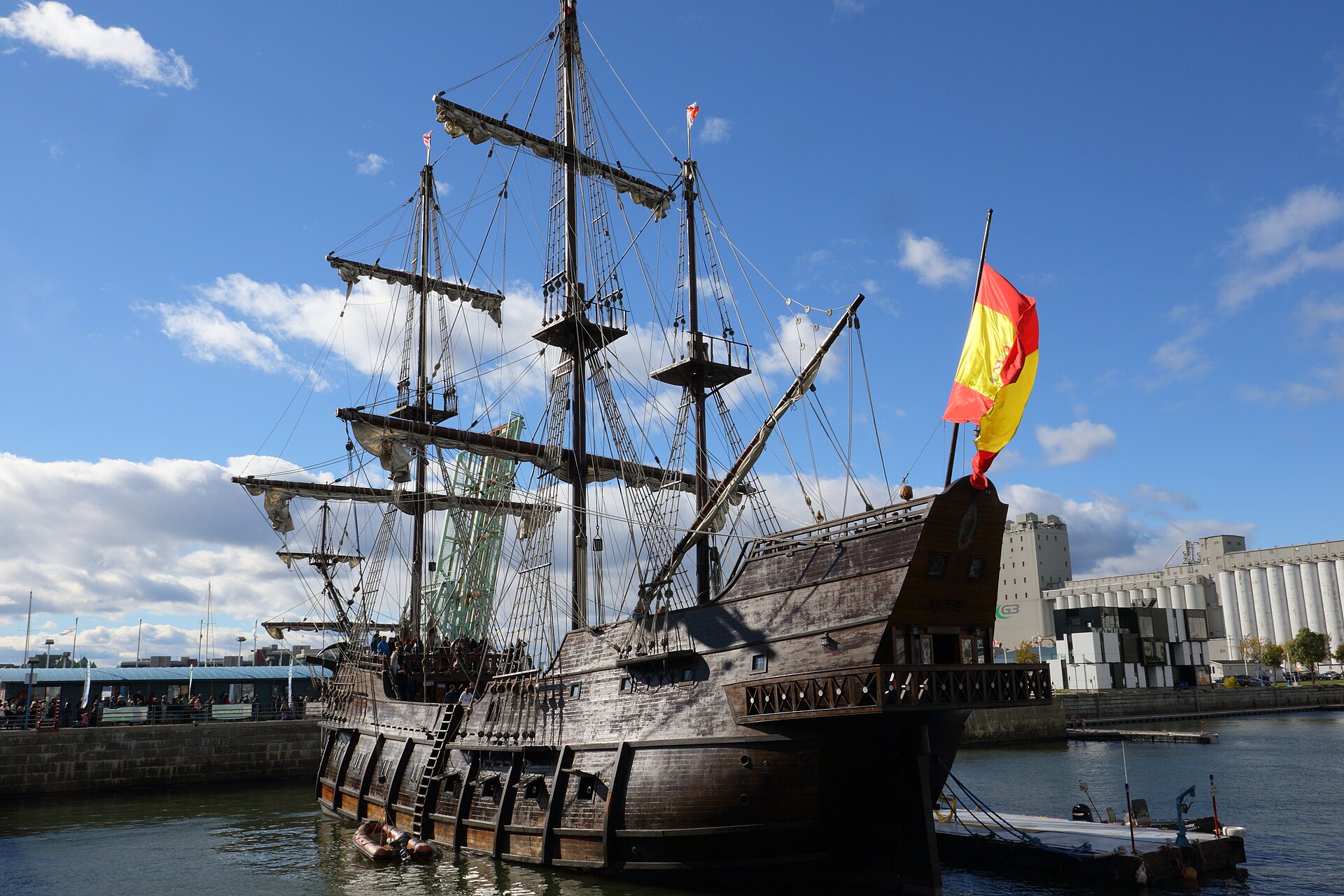 El Galeón, a 17th-century Spanish galleon replica in Quebec City in 2016. |
 2016年にケベックシティに建造された17世紀のスペインのガレオン船のレプリカ「エル・ガレオン」。 |
| 1 [1] Galeão – Navegações Portuguesas by Francisco Contente Domingues (in Portuguese) 2. Despite this kind of ship (or only a close model of art) was already depicted in the heraldry of the Foral of Lisbon (of D. Manuel I) in 1502, it is in 1510 (as also in some of the following years after 1510) the appearance of the Portuguese oceanic galleon in the records. It is however from 1519 that their number increases substantially, but gradually. It was an evolution and a gradual improvement in the design made during the first quarter of the century – technical improvement which continued until the second half of the century. The Portuguese galleon evolved from the square rigged caravel and was a compromise between the great carrack or nau and the aforementioned square rigged caravel or war caravel (also called caravela de armada or Portuguese man of war) that evolved into a new design of ship, but keeping its hull design similar to the galley.[1] It was also more maneuverable, more robust and heavily armed. 3. Black, Jeremy (28 March 1996). The Cambridge Illustrated Atlas of Warfare: Renaissance to Revolution, 1492-1792. Cambridge University Press. p. 16. ISBN 978-0-521-47033-9. Retrieved 18 September 2024. 4. Timothy R. Walton, The Spanish Treasure Fleets, Pineapple Press Inc, 2002, p. 57 ISBN 1-56164-261-4 5. Mariano González Arnao, A prueba de piratas, n.º 61 de La aventura de la Historia, Arlanza Ediciones, November 2003 6. Carlos Gómez-Centurión, La Armada Invencible, Biblioteca Básica de Historia -Monografías-, Anaya, Madrid, 1987, ISBN 84-7525-435-5 7. Lane, Kris E. Pillaging the Empire: Piracy in the Americas 1500–1750. M. E. Sharpe, 1998. 8. Grenier, Robert (2007). Grenier, Robert; Bernier, Marc-Andre; Stevens, Willis (eds.). The Underwater Archaeology of Red Bay. Vol. 3: The 24M Hull. Ottawa: Parks Canada. ISBN 9780660196527. 9. Phillips, Carla Rahn (1994). "The Caravel and the Galleon". In Gardiner, Robert; Unger, Richard W (eds.). Cogs, Caravels and Galleons : the sailing ship, 1000-1650. London: Conway Maritime Press. ISBN 0851775608. 10. Adams, Jonathan (2013). A maritime archaeology of ships: innovation and social change in medieval and early modern Europe (First ed.). Oxford, UK: Oxbow Books. ISBN 9781842172971. 11. [2] Os Navios e as Técnicas Náuticas Atlânticas nos Séculos XV e XVI: Os Pilares da Estratégia 3C – Rear Admiral Antonio Silva Ribeiro – Revista Militar (in Portuguese) 12. [3] Archived 2017-02-18 at the Wayback Machine Galeão – Navegações Portuguesas by Francisco Contente Domingues (in Portuguese) 13. Quintela, Inácio da Costa (1839). Anais da Marinha Portuguesa (in Portuguese). Lisbon: Lisbon Academy of Sciences. p. 410. 14. "The galleon evolved in response to Spain's need for an ocean-crossing cargo ship that could beat off corsairs. Pedro de Menéndez, along with Álvaro de Bazán (hero of Lepanto), is credited with developing the prototypes which had the long hull—and sometimes the oars—of a galley married to the poop and prow of a Portuguese nau or merchantman. Galeones were classed as 1-, 2- or 3-deckers, and stepped two or more masts rigged with square sails and topsails (except for a lateen sail on the mizzenmast). Capacity ranged up to 900 tons or more. Menéndez's San Pelayo of 1565 was a 900-ton galleon which was also called a nau and galeaza. She carried 77 crewmen, 18 gunners, transported 317 soldiers and 26 families, as well as provisions and cargo. Her armament was iron."—p.100 Menéndez: Pedro Menéndez de Avilés, Captain General of the Ocean Sea Albert C. Manucy, published 1992 by Pineapple Press, Inc 15. Walton, Timothy R. (2002).The Spanish Treasure Fleets. Pineapple Press Inc, p. 57. ISBN 1-56164-261-4 16. "Fragments of Ancient English Shipwrightry". Archived from the original on 2011-07-09. Retrieved 2007-04-26. 17. Little, Benerson (2010). "Spanish Galleons and Portuguese Carracks". Pirate Hunting: The Fight Against Pirates, Privateers, and Sea Raiders from Antiquity to the Present. Washington, DC: Potomac. p. 145. ISBN 978-1-59797-291-8. Called by her crew Cacafuego ... fire shitter |
1 [1] Galeão – Navegações Portuguesas(フランシスコ・コンテネ・ドミンゲス著、ポルトガル語) 2. このような船(または芸術作品としての類似モデル)は、1502年のリスボン特権令(ドン・マヌエル1世)の紋章に既に描かれていたが、ポルトガル海洋ガ レオン船が記録に初めて登場したのは1510年(1510年以降のいくつかの年にも同様)である。しかし、その数が大幅に増加し始めたのは1519年から で、徐々に増加していった。これは、世紀の最初の四半期に設計における進化と段階的な改善が行われた結果であり、技術的な改善は世紀の後半まで継続した。 ポルトガルガレオン船は、四角帆のカラベル船から進化し、大型のカラック船またはナウ船と、前述の四角帆のカラベル船または戦用カラベル船(ポルトガル戦 艦とも呼ばれる)の間の妥協点として、新たな船の設計へと発展した。ただし、船体の設計はガレー船に類似していた。[1] また、より操縦性が高く、頑強で、武装が充実していた。 3. Black, Jeremy (1996年3月28日). The Cambridge Illustrated Atlas of Warfare: Renaissance to Revolution, 1492-1792. Cambridge University Press. p. 16. ISBN 978-0-521-47033-9. 2024年9月18日閲覧。 4. ティモシー・R・ウォルトン、『スペインの宝船隊』、パインアップル・プレス社、2002年、57ページ ISBN 1-56164-261-4 5. マリアーノ・ゴンサレス・アルナオ、『海賊に挑む』、歴史の冒険シリーズ第61号、アルランサ・エディシオンズ、2003年11月 6. カルロス・ゴメス・セントゥリオン、『無敵艦隊』、歴史基本書庫 -モノグラフ-、アナヤ、マドリード、1987年、ISBN 84-7525-435-5 7. クリス・E・レーン、『帝国を略奪する:1500年から1750年のアメリカ大陸の海賊』 M. E. Sharpe、1998年。 8. グレニエ、ロバート (2007)。グレニエ、ロバート、ベルニエ、マーク・アンドレ、スティーブンス、ウィリス (編)。レッドベイの水中考古学。第 3 巻:24M 船体。オタワ:パークス・カナダ。ISBN 9780660196527。 9. フィリップス、カーラ・ラーン (1994)。「カラベル船とガレオン船」 ガーディナー、ロバート、アンガー、リチャード W (編)。コグ船、カラベル船、ガレオン船:帆船、1000-1650。ロンドン:コンウェイ・マリタイム・プレス。ISBN 0851775608。 10. アダムス、ジョナサン (2013)。『A maritime archaeology of ships: innovation and social change in medieval and early modern Europe』 (初版)。英国オックスフォード:オックスボウ・ブックス。ISBN 9781842172971。 11. [2] 15世紀と16世紀の大西洋における船と航海技術:3C戦略の柱 – アントニオ・シルバ・リベイロ少将 – Revista Militar(ポルトガル語) 12. [3] 2017年2月18日にウェイバックマシンでアーカイブされた Galeão – Navegações Portuguesas by Francisco Contente Domingues (ポルトガル語) 13. クインテラ、イナシオ・ダ・コスタ (1839). Anais da Marinha Portuguesa (ポルトガル語). リスボン: リスボン科学アカデミー. p. 410. 14. 「ガレオン船は、海賊を撃退できる大洋横断貨物船を必要としたスペインの要請に応じて発展した。ペドロ・デ・メネンデスとアルヴァロ・デ・バサン(レパン トの英雄)は、ガレー船の長い船体(時には櫂も備えた)とポルトガル船の船尾と船首を組み合わせた原型を開発したとされる。ガレオン船は1甲板、2甲板、 3甲板に分類され、2本以上のマストに四角帆とトップセイル(ミズンマストにはラテンセイルを除く)を装備していた。容量は900トン以上にも及んだ。メ ネンデスの1565年のサン・ペラヨは900トンのガレオン船で、ナウとガレアザとも呼ばれた。乗組員77名、砲手18名、兵士317名、家族26名、食 料品と貨物を搭載していた。武装は鉄製だった。」—p.100 メネンデス:ペドロ・メネンデス・デ・アビレス、大西洋総督 アルベルト・C・マヌシー、1992年、パインアップル・プレス社発行 15. ウォルトン、ティモシー・R. (2002).『スペインの宝船隊』パインアップル・プレス社、p. 57. ISBN 1-56164-261-4 16. 「古代イングランドの造船技術に関する断片」。2011年7月9日にオリジナルからアーカイブ。2007年4月26日に取得。 17. リトル、ベネソン(2010)。「スペインのガレオン船とポルトガルのカラック船」。『海賊狩り:古代から現代までの海賊、私掠船、海賊団との戦い』。ワ シントンD.C.:ポトマック。145ページ。ISBN 978-1-59797-291-8。乗組員からは「カカフエゴ(火のクソ野郎)」と呼ばれていた。 |
| References Alertz, U. (1991) Vom Schiffbauhandwerk zur Schiffbautechnik : die Entwicklung neuer Entwurfs- und Konstruktionsmethoden im italienischen Galeerenbau (1400–1700), Hamburg : Kovač, ISBN 3-925630-56-2 Humble, R. and Bergin, M. (1993) A 16th century galleon, Inside story series, Hemel Hempstead : Simon & Schuster, ISBN 0-7500-1339-7 Kirsch, P. (1990) The Galleon: the great ships of the Armada era, London : Conway Maritime, ISBN 0-85177-546-2 Rutland, J. (1988) A galleon, 2nd rev. ed., Connaty, M. (ed.), London : Kingfisher, ISBN 0-86272-327-2 Serrano Mangas, F. (1992) Función y evolución del galeón en la carrera de Indias, Colección Mar y América 9, Madrid : Editorial MAPFRE, ISBN 84-7100-285-X |
参考文献 Alertz, U. (1991) Vom Schiffbauhandwerk zur Schiffbautechnik : die Entwicklung neuer Entwurfs- und Konstruktionsmethoden im italienischen Galeerenbau (1400–1700), Hamburg : Kovač, ISBN 3-925630-56-2 Humble, R. and Bergin, M. (1993) 16世紀のガレオン船、Inside story series、ヘメルヘムステッド:Simon & Schuster、ISBN 0-7500-1339-7 キルシュ、P. (1990) 『ガレオン船:アルマダ時代の偉大な船たち』、ロンドン:コンウェイ・マリタイム、ISBN 0-85177-546-2 ラトランド、J. (1988) 『ガレオン船』、第 2 改訂版、コナティ、M. (編)、ロンドン:キングフィッシャー、 ISBN 0-86272-327-2 セラーノ・マンガス、F. (1992) Función y evolución del galeón en la carrera de Indias、コレシオン・マール・イ・アメリカ 9、マドリード:エディトリアル・MAPFRE、ISBN 84-7100-285-X |
| https://en.wikipedia.org/wiki/Galleon |
リ ンク
文 献
そ の他の情報
CC
Copyleft,
CC, Mitzub'ixi Quq Chi'j, 1996-2099